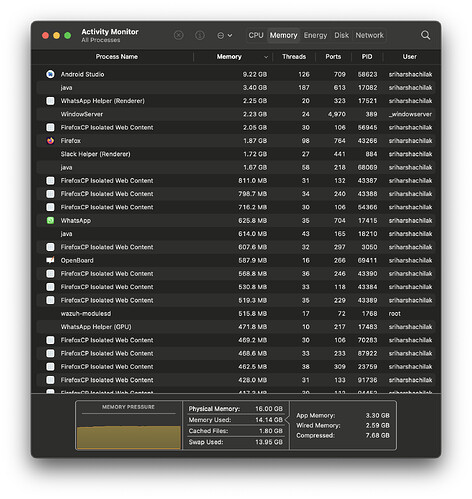Hi,
I’ve been using Manjaro for an year now without any major problems and with this thread, I’m planning to increase my learning in the internals (I’m already using Testing branch for more than 6 months now) of OS and Linux.
Recently I’ve got a MacBook Pro from work and I’m stunned by the stability. For example, I had three windows of Firefox with 50 tabs each, Xcode, iOS Simulator, Android Studio, Android Emulator, WhatsApp, Slack and my E-Mail and Calender clients open for 30 days without any reboot and still it is fluid.
So latest info from Activity Monitor there, Firefox was using 20 GB of memory (over multiple processes), Android Studio was using 8 GB of memory, Android Emulator was using 7 GB, Xcode and iOS Simulator were using 4 GB each, Slack and WhatsApp are using 1 GB together. Still, switching between windows and apps was super fluid.
I’d love to try to get to that stability in Manjaro, and even if the goals are too high, which I agree they are, I’m sure I’d love to learn a lot more just by attempting them.
My current state:
- 16 GB of RAM (2 x8G sticks)
- Intel i5-11400H
- NVIDIA RTX 3060 Mobile
- 1x 512 GB SSD (EFI and OS partitions)
- 1x 1 TB SSD (Home partition)
- BTRFS filesystem
- 20 GB Swapfile
Both the systems are always powered on and connected to a 4K Monitor (Samsung 28" LU28R550UQWXXL UHD) set at native resolution using HDMI.
Now, the issues I still face with Manjaro (not major, but again, I’d love to try fix them):
- I cannot hibernate once I open Firefox and Slack and Android Studio for a week.
- After three days, Alt Tabbing into any other process is taking 4-5 seconds.
- MacOS has a separate hibernation file which is separate from Swap memory.
- Temperatures in Manjaro are twice that of the MacBook Pro. CPU and GPU are at 50-60 C here, where MBP has 28-30C.
What are the immediate goals?
- Find a way to have multiple Swap Files while keeping Hibernation working. I think it would be better, since having a single Swap file of 20 GB might be taxing since it has to be kept mapped in memory.
- Find a way to dynamically increase Swap Size. This should allow for less compression and decompression times in memory pages.
Goal for future would be to try to have a separate hibernation file, so even if I fill up all the available swap, I’d be able to hibernate and resume back.
I’ve looked at zram-generator, but not sure how to get it working with BTRFS with my current setup.
Also, I don’t care about any data loss on this system, because I have made three backups already and I’m fine with bricking the SSDs too. I’m doing this, mainly for a learning experience.
Please guide me. Where should I start first?
